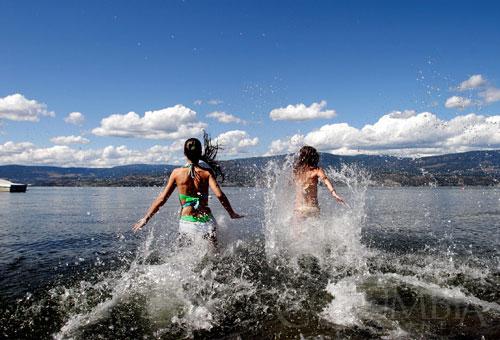What’s being done to preserve this important lake?

Okanagan Lake, part of the Columbia River drainage basin, has been called “the most important and valuable lake in British Columbia,” critical to the Okanagan Valley’s culture and economy. It is not just a hot spot for recreation and real estate; it’s a source of drinking water, a sustaining force in agriculture, and important habitat for a variety of species.
The pressures and popularity evident during my paddling trip for “Shore leave” in the Summer 2013 issue made me wonder about the iconic lake’s future. Of course, others have been wondering about it long before me ? the local regional districts formed the Okanagan Basin Water Board in the late 1960s. The water governance body works to identify and resolve critical issues in the 8,000-square-kilometre Okanagan watershed, such as:
Demand
According to Stats Canada, the Okanagan Valley has less water available per person than anywhere else in the country, yet residents use twice as much as the average Canadian. As the population mushrooms, demand will only increase. Currently, 24 percent of water used goes to residential landscaping. The OBWB promotes xeriscaping practices.
“If the population is going to grow as projected we will have to greatly reduce outdoor domestic water use or there will be shortages,” says OBWB executive director Anna Warwick Sears.
“People formed their ideas about the availability of water when there were less people here. Now we have to come to terms with the fact that this is an arid environment and that big green lawns may not be appropriate for the long term,” she adds.
Climate Change
Scientists expect that snowpack will be unpredictable in the future, making it difficult to store and manage water from one year to the next, with swings from drought to flood.
OBWB is working on conservation policy initiatives that will help ensure there is enough of a “buffer” of water reserved for use during dry years, and is gathering data to better understand how climate change will impact water availability.
Milfoil Control
Invasive Eurasian milfoil appeared in the lake in the early 1970s and began to compete with native vegetation and disrupt the ecosystem. The OBWB harvests the plant in the summer and rototills the root during the fall and winter to control it.
Invasive Mussels
Warwick Sears considers zebra mussels to be the biggest potential threat currently facing the lake. If the invasive species is introduced they will clog up water intake and sewage pipes and clutter beaches with their sharp shells.
A new public awareness campaign called “Don’t Move a Mussel” is currently underway. OBWB is also joining forces with the Invasive Species Council of BC and the Okanagan and Similkameen Invasive Species Society in their efforts to educate boaters about the risks of invasive mussels.
“I think people really work together well on the lake,” says Warwick Sears. “Everyone has great love for the lake, that’s why people are in the Okanagan. So we have huge support to protect it and preserve it.”
For more on the Okanagan Basin Water Board’s initiatives see obwb.ca.

